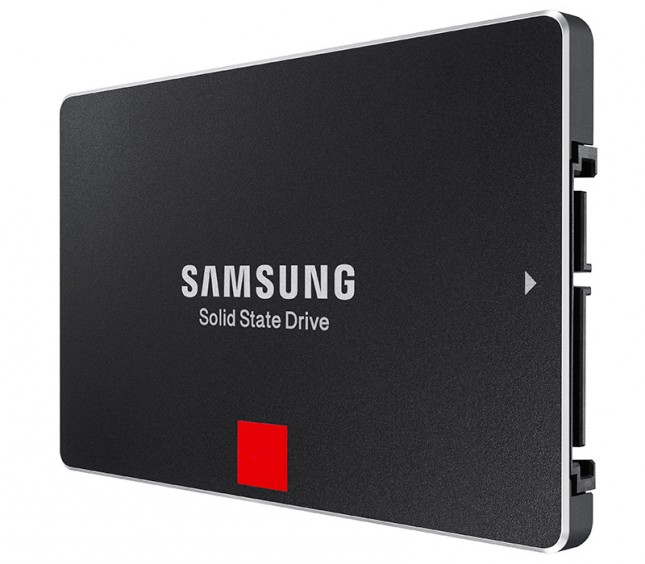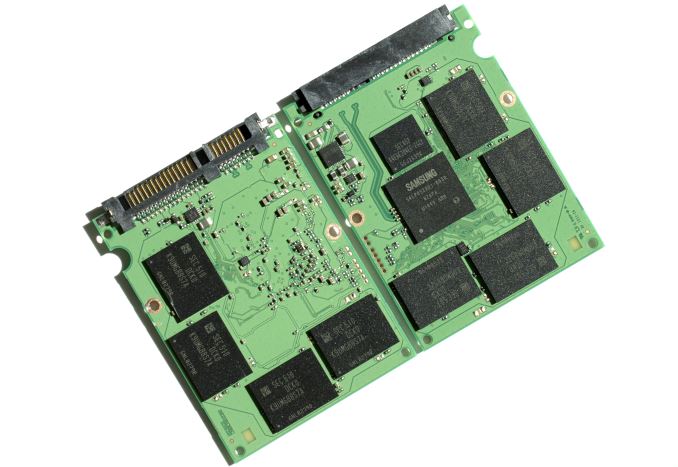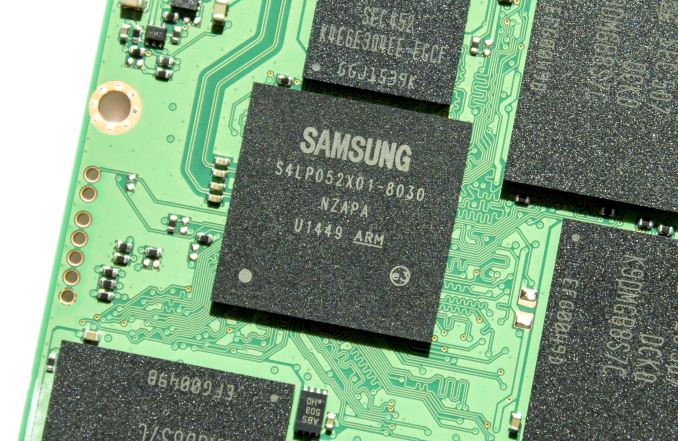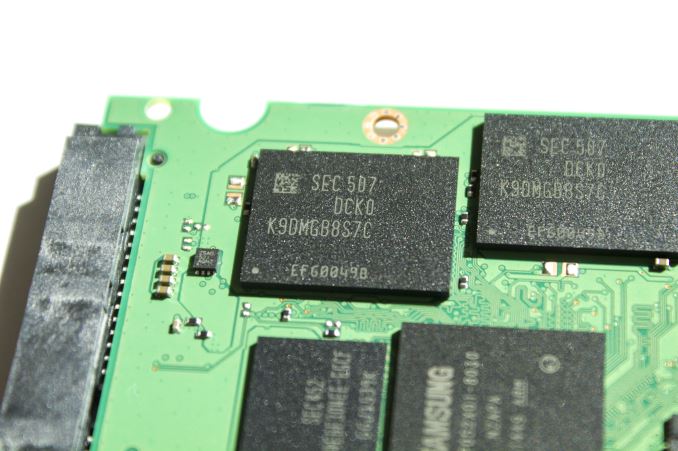The 2TB Samsung 850 Pro & EVO SSD Review
by Kristian Vättö on July 23, 2015 10:00 AM EST
During the early days of SSDs, we saw rather quick development in capacities. The very first SSDs were undoubtedly small, generally 32GB or 64GB, but there was a need for higher capacities to make SSDs more usable in client environments. MLC NAND caused a rapid decline in prices and the capacities quickly increased to 128GB and 256GB. 512GB also came along fairly soon, but for a long while the 512GB drives cost more than a decent gaming PC with prices being over $1000.
I would argue that the 512GB drives were introduced too early - the adoption was minimal due to the absurd price. The industry learned from that and instead of pushing 1TB SSDs to the market at over $1000, it wasn't until 2013 when Crucial introduced the M500 with the 960GB model being priced reasonably at $600. Nowadays 1TB has become a common capacity in almost every OEM's lineup, which is thanks to both lower NAND prices and controllers being sophisticated enough to manage 1TB of NAND. The next milestone is obviously the multi-terabyte era, which we are entering with the release of 2TB Samsung 850 Pro and EVO models.
Breaking capacity thresholds involves work on both the NAND and the controller side. All controllers have a fixed number of die they can talk to and for modern 8-channel controllers with eight chip enablers (CEs) per channel the limit is typically 64 dies. With 128Gbit (16GB) being the common NAND die capacity today, 64 dies yields 1,024GB or 1TB (as it's often marketed). It's possible to utilize a single CE for managing more than one die (which is what e.g. Silicon Motion does to achieve 1TB with a 4-channel controller), but it adds complexity to the firmware design and there's a negative performance impact as the two dies on the same chip enabler can't be accessed simultaneously.
Increasing NAND capacity per die is one way to work around the channel/CE limitation, but it's generally not the most efficient way. First off, doubling the capacity of the die increases complexity substantially because you are effectively dealing with twice the number of transistors per die. The second drawback is reduced write performance, especially at smaller capacities, as SSDs rely heavily on parallelism for performance, so doubling the capacity per die will cut parallelism in half. That reduces the usability of the die in capacity sensitive applications such as eMMC storage, which don't have many die to begin with (as the same dies are often used in various different applications ranging from mobile to enterprise).
The new MHX controller
The real bottleneck, however, is the DRAM controller. Today's NAND mapping table designs tend to require about 1MB of DRAM per 1GB of NAND for optimal performance, so breaking the 1TB limit requires a DRAM controller capable of supporting 2GB of DRAM. From a design standpoint, implementing a beefier DRAM controller isn't a massive challenge, but it eats both die and PCB area and hence increases cost. Given how 2TB SSDs are currently a relatively small niche, embedding a DRAM controller with 2GB support for a mainstream controller isn't very economical, which is why today's client-grade SSD controller usually support up to 1GB to increase cost efficiency.
Initially the 850 EVO was supposed to carry a 2TB SKU at the time of launch, but Samsung didn't consider the volume to be high enough. As Samsung is the number one manufacturer of client SSDs and supplies millions of drives to PC OEMs, the company is not really in the business of making low volume niche products, hence the release of 2TB client SSDs was postponed in wait for lower pricing and higher demand as a result.
| Comparison of Samsung SSD Controllers | ||||
| MDX | MEX | MGX | MHX | |
| Core Architecture | ARM Cortex R4 | |||
| # of Cores | 3 | 3 | 2 | 3 |
| Core Frequency | 300MHz | 400MHz | 550MHz | 400MHz |
| Max DRAM | 1GB | 1GB | 512MB (?) | 2GB |
| DRAM Type | LPDDR2 | LPDDR2 | LPDDR2 | LPDDR3 |
The new 2TB versions of the 850 Pro and EVO both use Samsung's new MHX controller. I was told it's otherwise identical to the MEX besides the DRAM controller supporting up to 2GB of LPDDR3, whereas the MEX only supports 1GB of LPDDR2. The MGX is the lighter version of MEX with two higher clocked cores instead of three slower ones, and it's found in the 120GB, 250GB and 500GB EVOs.
| Samsung SSD 850 Pro Specifications | |||||
| Capacity | 128GB | 256GB | 512GB | 1TB | 2TB |
| Controller | MEX | MHX | |||
| NAND | Samsung 32-layer MLC V-NAND | ||||
| NAND Die Capacity | 86Gbit | 128Gbit | |||
| DRAM | 256MB | 512MB | 512MB | 1GB | 2GB |
| Sequential Read | 550MB/s | 550MB/s | 550MB/s | 550MB/s | 550MB/s |
| Sequential Write | 470MB/s | 520MB/s | 520MB/s | 520MB/s | 520MB/s |
| 4KB Random Read | 100K IOPS | 100K IOPS | 100K IOPS | 100K IOPS | 100K IOPS |
| 4KB Random Write | 90K IOPS | 90K IOPS | 90K IOPS | 90K IOPS | 90K IOPS |
| DevSleep Power | 2mW | 5mW | |||
| Slumber Power | Max 60mW | ||||
| Active Power (Read/Write) | Max 3.3W / 3.4W | ||||
| Encryption | AES-256, TCG Opal 2.0 & IEEE-1667 (eDrive supported) | ||||
| Endurance | 150TB | 300TB | |||
| Warranty | 10 years | ||||
Specification wise the 2TB 850 Pro is almost identical to its 1TB sibling. The performance on paper is an exact match with the 2TB model drawing a bit more power in DevSleep mode, which is likely due to the additional DRAM despite LPDDR3 being more power efficient than LPDDR2. Initially the 850 Pro was rated at 150TB of write endurance across all capacities, but Samsung changed that sometime after the launch and the 512GB, 1TB and 2TB versions now carry 300TB endurance rating along with a 10-year warranty.
There's another hardware change in addition to the new MHX controller as the NAND part number suggests that the 2TB 850 Pro uses 128Gbit dies instead of the 86Gbit dies found in the other capacities. The third character, which is a U in this case, refers to the type of NAND (SLC, MLC or TLC) and the number of dies, and Samsung's NAND part number decoder tells us that U stands for a 16-die MLC package. With eight NAND packages on the PCB, each die must be 128Gbit (i.e. 16GiB) to achieve raw NAND capacity of 2,048GiB. 2,048GB out of that is user accessible space, resulting in standard ~7% over-provisioning due to GiB (1024^3 bytes) to GB (1000^3 bytes) translation.
According to Samsung, this is still a 32-layer die, which would imply that Samsung has simply developed a higher capacity die using the same process. It's logical that Samsung decided to go with a lower capacity die at first because it's less complex and yields better performance at smaller capacities. In turn, a larger die results in additional cost savings due to peripheral circuitry scaling, so despite still being a 32-layer part the 128Gbit die should be more economical to manufacture than its 86Gbit counterpart.
| Samsung SSD 850 EVO Specifications | ||||||
| Capacity | 120GB | 250GB | 500GB | 1TB | 2TB | |
| Controller | MGX | MEX | MHX | |||
| NAND | Samsung 32-layer 128Gbit TLC V-NAND | |||||
| DRAM | 256MB | 512MB | 1GB | 2GB | ||
| Sequential Read | 540MB/s | 540MB/s | 540MB/s | 540MB/s | 540MB/s | |
| Sequential Write | 520MB/s | 520MB/s | 520MB/s | 520MB/s | 520MB/s | |
| 4KB Random Read | 94K IOPS | 97K IOPS | 98K IOPS | 98K IOPS | 98K IOPS | |
| 4KB Random Write | 88K IOPS | 88K IOPS | 90K IOPS | 90K IOPS | 90K IOPS | |
| DevSleep Power | 2mW | 2mW | 2mW | 4mW | 5mW | |
| Slumber Power | 50mW | 60mW | ||||
| Active Power (Read/Write) | Max 3.7W / 4.4W | 3.7W / 4.7W | ||||
| Encryption | AES-256, TCG Opal 2.0, IEEE-1667 (eDrive) | |||||
| Endurance | 75TB | 150TB | ||||
| Warranty | Five years | |||||
Like the 2TB Pro, the EVO has similar performance characteristics with the 1TB model. Only power consumption is higher, but given the increase in NAND and DRAM capacities that was expected.
As the 32-layer TLC V-NAND die was 128Gbit to begin with, Samsung didn't need to develop a new higher capacity die to bring the capacity to 2TB. The EVO also uses eight 16-die packages with the only difference to Pro being TLC NAND, which is more economical to manufacture since storing three bits in one cell yields higher density than two. Out of the 2,048GiB of raw NAND, 2,000GB is user-accessible, which is 48GB less than in the 2TB 850 Pro, but the TurboWrite SLC cache eats a portion of NAND and TLC tends to require a bit more over-provisioning to keep the write amplification low for endurance reasons.
| AnandTech 2015 SSD Test System | |
| CPU | Intel Core i7-4770K running at 3.5GHz (Turbo & EIST enabled, C-states disabled) |
| Motherboard | ASUS Z97 Deluxe (BIOS 2205) |
| Chipset | Intel Z97 |
| Chipset Drivers | Intel 10.0.24+ Intel RST 13.2.4.1000 |
| Memory | Corsair Vengeance DDR3-1866 2x8GB (9-10-9-27 2T) |
| Graphics | Intel HD Graphics 4600 |
| Graphics Drivers | 15.33.8.64.3345 |
| Desktop Resolution | 1920 x 1080 |
| OS | Windows 8.1 x64 |
- Thanks to Intel for the Core i7-4770K CPU
- Thanks to ASUS for the Z97 Deluxe motherboard
- Thanks to Corsair for the Vengeance 16GB DDR3-1866 DRAM kit, RM750 power supply, Hydro H60 CPU cooler and Carbide 330R case














66 Comments
View All Comments
vFunct - Thursday, July 23, 2015 - link
Any info about the well known TRIM bug in these drives?vFunct - Thursday, July 23, 2015 - link
TRIM bug reported here: https://blog.algolia.com/when-solid-state-drives-a...and here:
https://bugs.launchpad.net/ubuntu/+source/fstrim/+...
Kristian Vättö - Thursday, July 23, 2015 - link
The bug turned out to be in the Linux kernel, not in Samsung SSDs, as you can see in the first link once you scroll down the updates. Samsung has developed a kernel patch to fix the issue too.BillyONeal - Thursday, July 23, 2015 - link
Well they patched the kernel to work around the firmware bug; but that doesn't mean it was a kernel bug.Kristian Vättö - Thursday, July 23, 2015 - link
There was never a problem with TRIM under Windows or OS X.DanNeely - Thursday, July 23, 2015 - link
IF you follow through to the mailing list discussion for the bug fix, the problem is with the kernel overwriting a pointer when it shouldn't be. If I'm following it correctly, it impacts any SSD brand in RAID0 with trim enabled.leexgx - Thursday, July 23, 2015 - link
did not affect the Intel SSDsmooninite - Thursday, July 23, 2015 - link
Kristian,There are two forms of TRIM these days. The original, Windows-supported, inline TRIM and the latest, queued TRIM. The latter is what is the problem on Samsung drives. I encourage you to fully investigate the issue.
Inline TRIM is known to cause delays with certain drives and certain host systems because it can take over IO on a drive and freeze other commands until TRIM is complete. The number of drives and systems effected is quite low, but it is enough for some people to disable TRIM or use a nightly TRIM script (fstrim).
sustainednotburst - Friday, July 24, 2015 - link
Algolia stated Queued Trim is disabled on their systems, so its not related to Queued Trim.editorsorgtfo - Thursday, July 23, 2015 - link
That was my first reaction, too. But judging from the message on the mailing list and the patch, it is indeed a kernel issue and not specific to Samsung drives. It seems so stem from using queued TRIM on software RAID0, which is a moderately questionable configuration anyway. I guess Algolia did not tell the whole (probably embarrassing) story since there is only one mention of Linux software RAID in the entire article. Maybe they didn't configure their Intel drives the same way?I was set on an Intel 730 for a 7mm SATA role up until a few minutes ago because I had read about this, too. But in light of this, one can probably use Kristian's "best 6Gbps SATA SSD" without excessive worry.